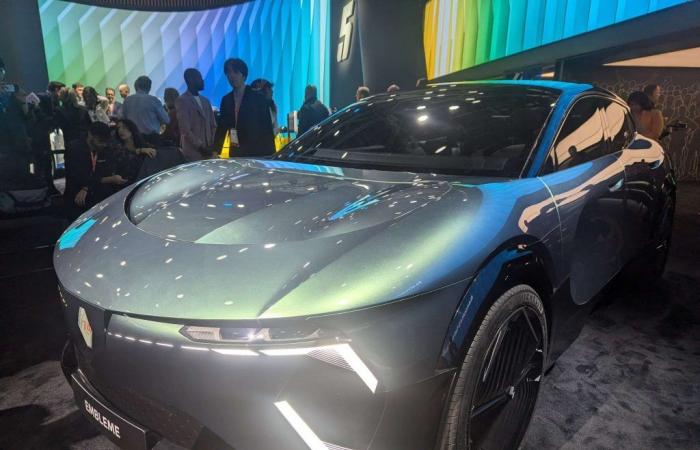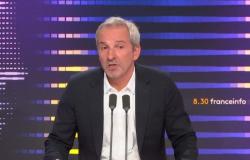
If the new Renault 4 E-Tech is the star of the brand’s stand this edition of the World car 2024a discreet concept takes its place alongside the other models. This is the Emblem. A name that porteporte the symbol of the philosophy that the brand’s coat of arms imagines for the end of the decade. Backlit, the diamond of the grille is animated, almost alive, like the rest of the light signature of this sedan, 4.80 meters long and quite tall. The car sports a rounded design, while having strong lines. However, it is far from the extravagant concepts of other manufacturers. The Emblem made in a realismrealism retained and it is not difficult to imagine it, almost as is, in traffic in a few years. But, behind the bodywork, hides a philosophy focused entirely on decarbonization and sustainabilitysustainability.
Futura was able to discuss this vision of the brand’s future with Sandeep Bhambra, the concept car design director. He is an inexhaustible enthusiast about design andADNADN of what will constitute the spirit of Renault for its vehicles in the future.
Futura: Looking at the Emblème concept, it seems above all to be a stylistic study with, certainly, strong lines, but without really breaking design codes. Apart from its shape, how will it be representative of the future of the brand?
Sandeep Bhambra : The Emblem undoubtedly reflects, in terms of design, what the vehicles in the Renault range will look like from 2029 to at least 2035. But, beyond stylestylethe Emblem is above all the expression of a strong message on the decarbonization of the brand in the future.
More than its design, it is in its engine that the Emblème concept is original. Contrary to what we can imagine of the vehicle of the future at Renault, on paper, the car will not be at all a lightninglightning of war. Its power is limited to 160 kW, which produces the equivalent of around 215 hp. But what is even more striking is its small 40 kW battery. It’s not much and it’s even half of what the Renault Scenic E-Tech has. And unlike the behemoths of the moment, with its electric platform based on the new AmpR Medium, it weighs only 1,750 kilos. It’s quite light for an electric sedan and this is, among other things, what allows it to reach a range of 350 kilometers. It is helped by its design combined with tips to reduce aerodynamic drag. This is particularly the case for its almost full rims.
Futura: In 2029, a range of 350 kilometers for an electric vehicle is ridiculously low, right?
SB : For the urban environment, it is quite sufficient, but it is true that to leave the city and undertake long journeys using the highway, it is not enough. Precisely, to go further, this carcar of the future hides another type of engine: a small fuel cellfuel cell has hydrogenhydrogen. It delivers up to 30 kW of power. This extended range allows you to travel an additional 350 kilometers. In other words, no need to take long breaks to recharge. The hydrogen is contained in a small 2.8 kilo tank with 700 barsbars of pressionpression. Ultimately, this combination saves time by regaining the practicality that a thermal vehicle can deliver while having a smaller, and therefore lighter, battery, for better energy efficiency in the city.
When the hydrogen tank is empty, simply recharge it in a few minutes at a gas station. For the city, the use remains that of a classic electric car.
Futura: Isn’t banking on hydrogen risky for 2030?
SB : Indeed, we do not yet know if hydrogen will be developed for the mobility of the future, but it is a concept, and combining a classic battery electric motor with a fuel cell combustioncombustion offers interesting options for Renault today. This is all the more important as in the future these two technologies should evolve towards greater ecological virtue, with denser batteries and greener hydrogen production.
Futura: A lightweight mass with a small battery, a mixed engine, the Emblem also aims to be low-carbon and sustainable in its design. Why is this the case?
SB : The Emblem also initiates an invisible revolutioneyeeye. In its life cycle, Renault’s car of the future will be up to 90% carbon-free. In a few weeks, we will present our partners and equipment manufacturers who are playing this card of decarbonization of their production. Most of the car’s components are designed in France to shorten circuits. The aim is to use low-cost materials carbonecarbone. Rather than applying several layers of different materials, whether for the structure of the vehicle or its trim which contributes to the design, we have developed a “mono-material” approach. The same materialmaterial with an identical color can thus be used for the same element, whether structural or comfort. For example, we use composite of linlin for certain coverings. Linen is produced in France. It is natural and recyclable. By developing this philosophy, we realized that even screens can be decarbonized!
This design considerably reduces the balance sheet of broadcastsbroadcasts carbon over the entire life cycle of the vehicle. Today, we must be clear, Renault is not more virtuous than the others despite its efforts. Thus, on a Captur having traveled around 200,000 kilometers, the balance reaches 50 tonnes of CO2. With electric, this figure is already halved. By employing our strategy used for the design of the Emblem, the car of the future will ultimately only emit 5 tonnes of CO over its entire life cycle.2or 10 times less than today!





